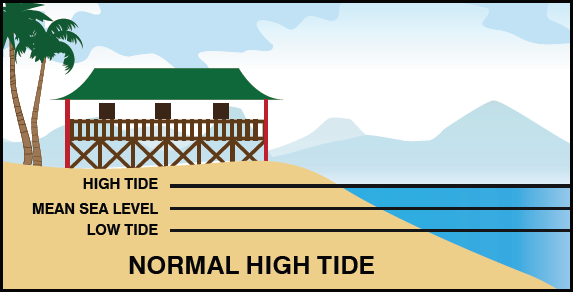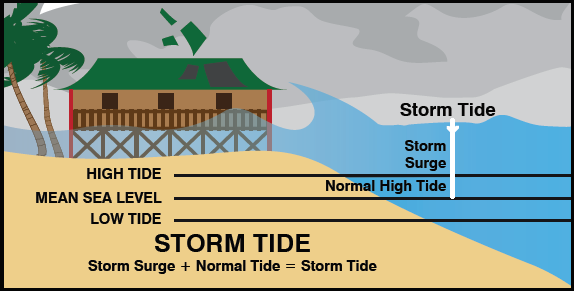Storm Surge
What is a storm surge
A storm surge is a rise above the normal water level along a shore resulting from strong onshore winds and / or reduced atmospheric pressure.
The combination of storm surge and normal (astronomical) tide is known as a ‘storm tide’.
The worst impacts occur when the storm surge arrives on top of a high tide and when this happens, the storm tide can reach areas that might otherwise have been safe. Additionally there are pounding waves generated by the powerful winds.
The combined effects of the storm tide and waves can destroy buildings, wash away roads and run ships aground.


The paths of cyclones are often unpredictable, which makes it hard to forecast exactly when and where a cyclone will cross the coast. This makes it difficult to predict how high the astronomical tide will be when the storm surge impacts, since the time difference between high and low tide is only a few hours. The Bureau of Meteorology issues warnings to the public that are based on the ‘worst case’ assumption that the cyclone will cross the coast at high tide.
The difference between strom surges and tsunamis
Storm surges and tsunamis are generated by quite different phenomena. While both can cause inundation and significant damage in coastal regions, they have quite different characteristics.
A storm surge is generated by weather systems forcing water onshore over a generally limited stretch of coastline. It wll normally build up over a few hours, as the cyclone or similiar weather system approaches the coast. Normally wind-waves on tiop of the surge will contribute to its impact.
A tsunami is generated by earthquakes, undersea landslides, volcanic eruptions, explosions or leteorites. These travel great distances, sometimes across entire oceans affecting vast lengths of coastal land.
BEFORE a storm surge
Check the following websites for advise:
Burdekin Shire Council www.burdekin.qld.gov.au
Burdekin Shire Council Emergency Dashboard https://disaster.burdekin.qld.gov.au
Burdekin Shire Council Disaster Coordination Centre Facebook page www.facebook.com/BurdekinDCC
Bureau of Meteorology www.bom.gov.au
Follow the following steps:
- Hold a family meeting to prepare your household Emergency Plan so everyone knows what to do, where to meet and how to get out.
- Prepare your Emergency and Evacuation Kits.
- Clean up the yard. Clear away all loose material.
- Check and fix loose fittings, such as railings. Check windows and install shutters if possible.
- Tie down sheds or other small structures not permanently fixed. Secure caravans, boats and vehicles or tie them together or to strong structures.
- Sandbag areas at risk from flooding, such as doors and windows where possible.
- Close all doors.
- Store potable water.
- Put important documents such as photo albums in plastic bags up high in cupboards.
- Identify how and where to turn off the mains supply for water, power and gas.
- Disconnect electrical items.
- Keep refrigerator and freezer doors closed so food will stay cool without power for several hours.
- Move livestock, pets, machinery and animal feed to higher ground.
- Move outdoor equipment, garbage, chemicals and poisons to a higher location.
- Know your Evacuation Zone (storm tide) and evacuation routes.
AFTER a storm surge
- Have a battery operated radio and tune into your local radio station and heed warnings and advice.
- Don’t go outside until officially advised it is safe.
- If you have evacuated, don’t return home until officially advised it is safe and don’t panic. Wait until water has fallen below floor level to enter a house.
- Don’t use electric appliances if wet.
- Beware of damaged power lines, bridges and trees.
- Do not enter flood waters - if it’s flooded forget it.
- Heed all warnings and don’t go sightseeing. Instead, check and offer help to neighbours, friends and family.
- Don’t make unnecessary telephone calls.
- Check whether electricity, gas or water supplies have been affected.
- Wear rubber boots or rubber-soled shoes and rubber or leather gloves.
- Watch for damaged flooring, walls and ceilings as well as unexpected visitors such as snakes.
- Treat all items exposed to floodwater as contaminated. Dispose of rubbish, wash mud, dirt and debris as soon as you can.
- Wash hands thoroughly after handling anything that has been in contact with floodwater.
- Follow any instructions for treating water and discard any food exposed to floodwater.

